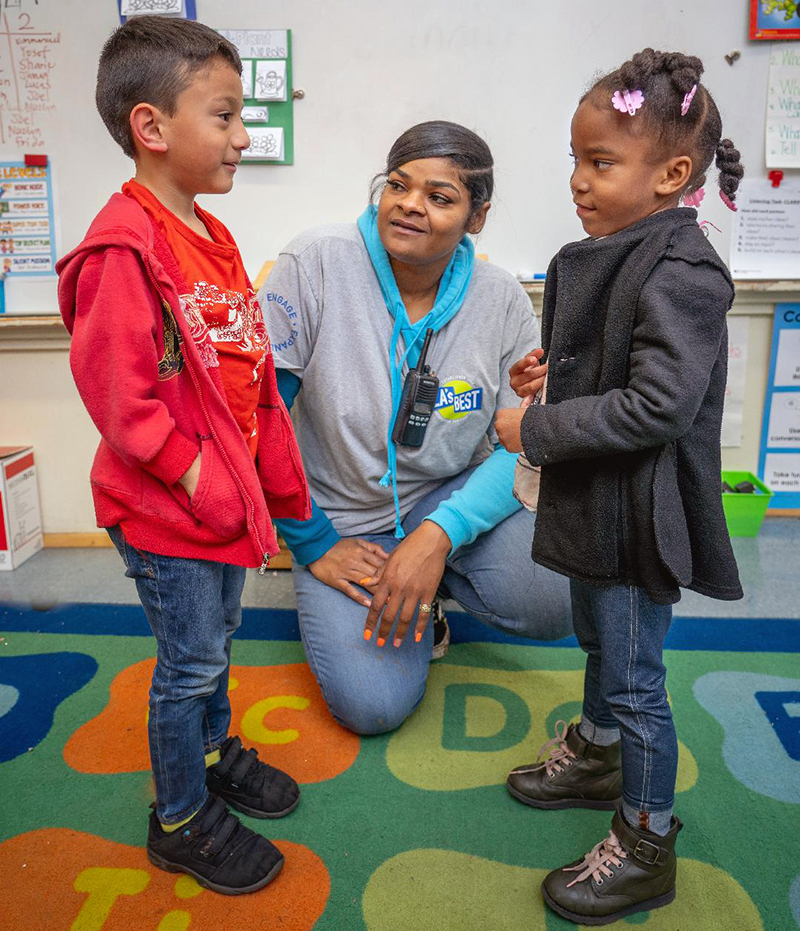
LA's Best
A coach at LA’s BEST Afterschool Enrichment Program in Los Angeles helps kids communicate. LA’s BEST has been integrating trauma-informed practices throughout the organization.
The increase of mental health problems in kids is one of the reasons LA’s BEST, an after-school provider serving 25,000 children in Los Angeles, has turned its attention to trauma.
“What’s dramatically up is anxiety and depression,” said Eric Gurna, president and CEO, citing national figures.
LA’s BEST serves kids ages 5 to 12 in some of the most economically distressed neighborhoods of Los Angeles.
While adverse childhood experiences occur in all socioeconomic and racial groups, “children growing up in conditions of poverty have significantly more exposure to [these] experiences,” Gurna said.
[Related: How One Philadelphia After-school Program Works to Be Trauma-informed]
[Related: Avoid Simplistic Thinking About Trauma-informed Care, Some Say]
He’s worked in the after-school field since the 1990s. However, he notes an increase in disturbing behavior among kids in LA’s BEST, including expressing suicidal thoughts and cutting themselves.
“It’s happening a lot more than in previous years,” he said.
As a result, three years ago LA’s BEST began a comprehensive effort to adopt trauma-informed practices.
Initially, Gurna was reluctant to get the organization involved with mental health professionals.
He was concerned about research showing that kids in poverty and kids of color are overdiagnosed with mental health conditions and overprescribed with medications.
“We wanted to be sure not to take an overly political approach so as not to contribute to that,” he said.
But Gurna was also inspired by school mental health leaders who were moving toward a goal of trauma-informed schools.
Staff training first
LA’s BEST is a public-private partnership of the city, the Los Angeles Unified School District and the private sector. It has 2,000 staff members and after-school programs in 200 schools.
“We started with pretty intensive professional development of our leadership so we as an organization could really understand the short and long-term impact of trauma,” Gurna said. “What’s most interesting to us is how we can create the conditions in our program for children to develop protective factors which will help them to be more resilient.”
LA’s BEST began to integrate the information throughout the organization, including new staff orientation and site coordinator training. The staff developed a common vocabulary and learned new practices to help kids ground themselves and regulate their emotions. It adopted Sanford Harmony, a social-emotional learning program that, among other things, helps frontline staff, mostly ages 18 to 24, frame their conversations with kids, Gurna said.
“Our staff are young adults. They’re not trained social workers or teachers,” he said. “We’re asking a lot of them. We have to put resources in their hands.”
The organization also created a full-time position known as the director of wellness, held by a psychiatric social worker from LAUSD.
“That person’s job is to support our staff in crisis response,” Gurna said.
In recent years, the organization was impacted by crimes in the communities it serves. In one high-profile case, three children who went to one of the schools where LA’s BEST is located were murdered by their father.
“We really saw the waves of trauma that happened as a result of this,” Gurna said.
While all crises are not of that magnitude, staff members need to be able to get assistance. Gurna hopes to have a similar professional in each of the organization’s five regions.
The director of wellness also integrates information about trauma into all the training.
LA’s BEST is also working with the Nathanson Family Resilience Center at the University of California at Los Angeles to adapt a family resilience training program for after-school use.
This story has been updated.





























